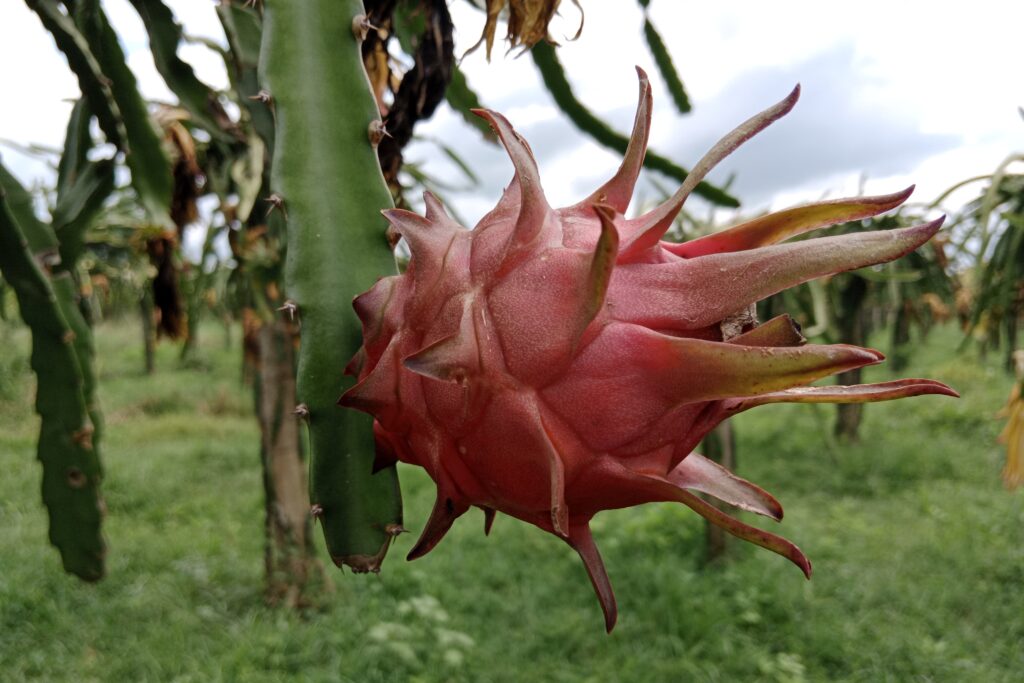Clove Farming
Clove farming can be a highly profitable long-term investment, with returns increasing significantly as the trees mature. The clove farming profit per acre becomes evident over time, with the break-even point typically reached by Year 15—when cumulative profit shifts from a loss of NRs. 99,920 in Year 14 to a positive gain of NRs. 68,080.
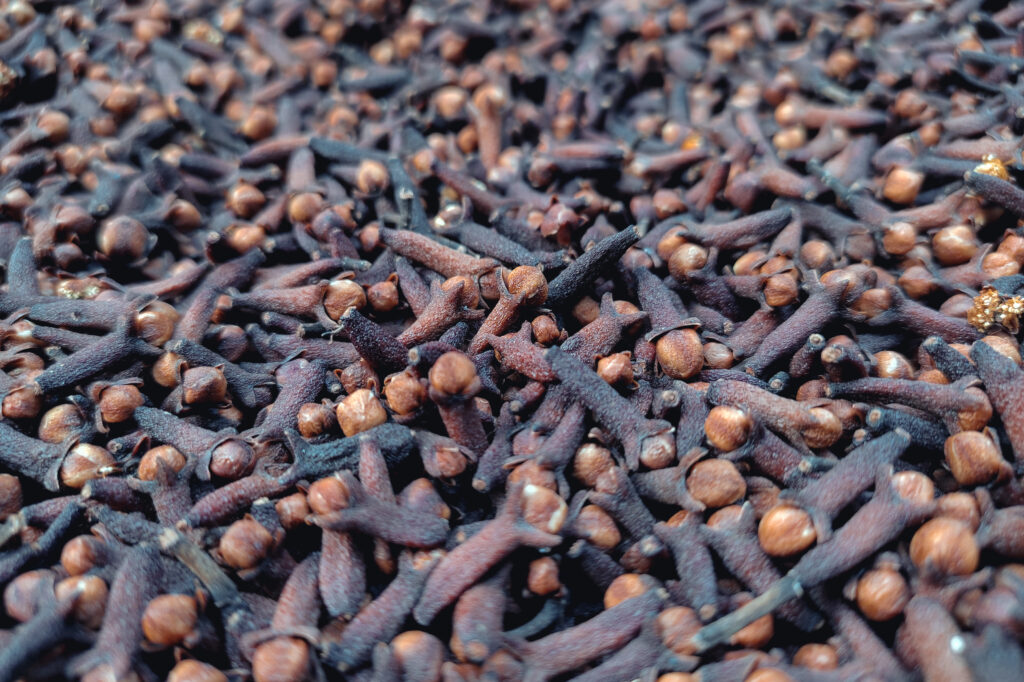
The most lucrative period occurs between Years 16 and 30, known as the peak profit phase, during which the plantation generates around 71.5% of the total profit, amounting to NRs. 2,842,500. During these years, farmers can expect an annual net profit of approximately NRs. 189,500 per acre, based on an average gross income of NRs. 252,000 and maintenance costs of NRs. 62,500.
Land Preparation
The first step in growing cloves is careful land preparation, which includes removing any existing vegetation, including weeds, trees, and shrubs. After deep plowing the soil to a depth of 25 to 30 cm, two to three harrowings are performed to break up clods and produce a fine tilth. Terracing is advised for sloped terrain, and proper drainage must be guaranteed to avoid waterlogging. To improve soil structure and planting readiness, the field should be allowed to weather for a few weeks following plowing.
Soil Type
Clove trees thrive in deep (minimum 1.5-2m), exceptionally well-drained soils rich in organic matter, with loamy textures being ideal. Suitable alternatives include lateritic soils, mineral-rich volcanic soils, and forest loams; sandy loams to clay loams are acceptable only if drainage is perfect. A slightly acidic to neutral pH (5.5 – 6.5) is optimal, while highly alkaline or saline soils must be avoided. Crucially, excellent drainage is absolutely essential, as cloves cannot tolerate any waterlogging, which is the most critical soil factor for their survival and growth.
Climatic Requirements
| Factor | Requirements | Notes |
| Temperature | • Optimal: 23°C – 32°C • Critical Limits: Below 10°C or above 35°C is detrimental • Fatal: Frost | Warm, humid tropical climate essential |
| Rainfall | • Ideal Annual: 1500 mm – 2500 mm • Distribution: Well-distributed year-round • Critical: Prolonged dry spells (>3 months) harmful | Irrigation essential during dry periods |
| Humidity | • Optimal Relative Humidity: 70% – 80% | Especially critical during flowering & bud development |
| Altitude | • Range: Sea level up to 800-900 meters (amsl) • Quality: Higher altitudes often produce better quality cloves | Higher altitudes may result in slower growth |
| Light (Sun) | • Young Plants (0-5 yrs): Requires 50-60% shade • Mature Trees: Filtered sunlight or partial sun (open with some light shade optimal) | Young plants need shade to prevent sunscorch; mature trees need more light |
Major Cultivars
Clove cultivars are primarily distinguished by their geographical origin, bud characteristics, oil content, and yield potential. The most widely cultivated global variety is Zanzibar (Syzygium aromaticum), prized for its large, plump, deep reddish-brown buds and high volatile oil content (15-20%). Pemba is very similar, often grouped with or considered a subtype of Zanzibar, also producing large buds.
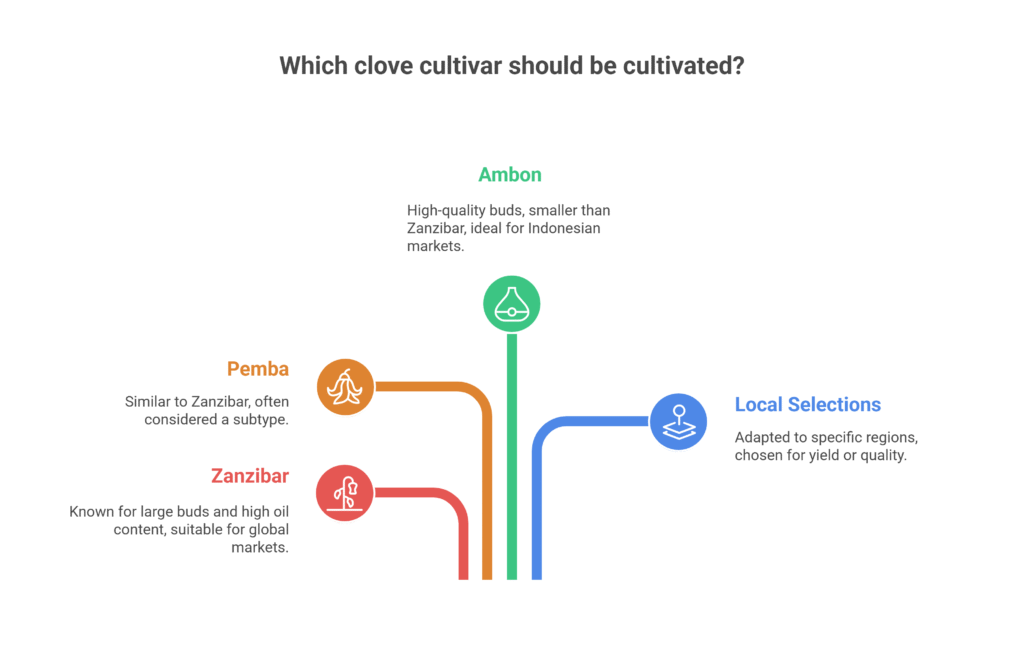
Ambon, a major Indonesian cultivar, yields slightly smaller buds than Zanzibar but maintains high quality. Beyond these named types, specific regions often propagate superior local selections identified for high yield or quality, with cultivar choice heavily dependent on local adaptation and market preferences for bud size or oil characteristics.
Seedling Rate per Acre
Approximately 112 clove seedlings are required per acre.
Planting
a). Planting Season
The optimum planting period for clove is from June to December. Sites with slopes facing south and west should be avoided due to potential exposure to harsh sunlight and dry winds, while north and north-eastern facing slopes are preferred for their cooler and more humid microclimate.
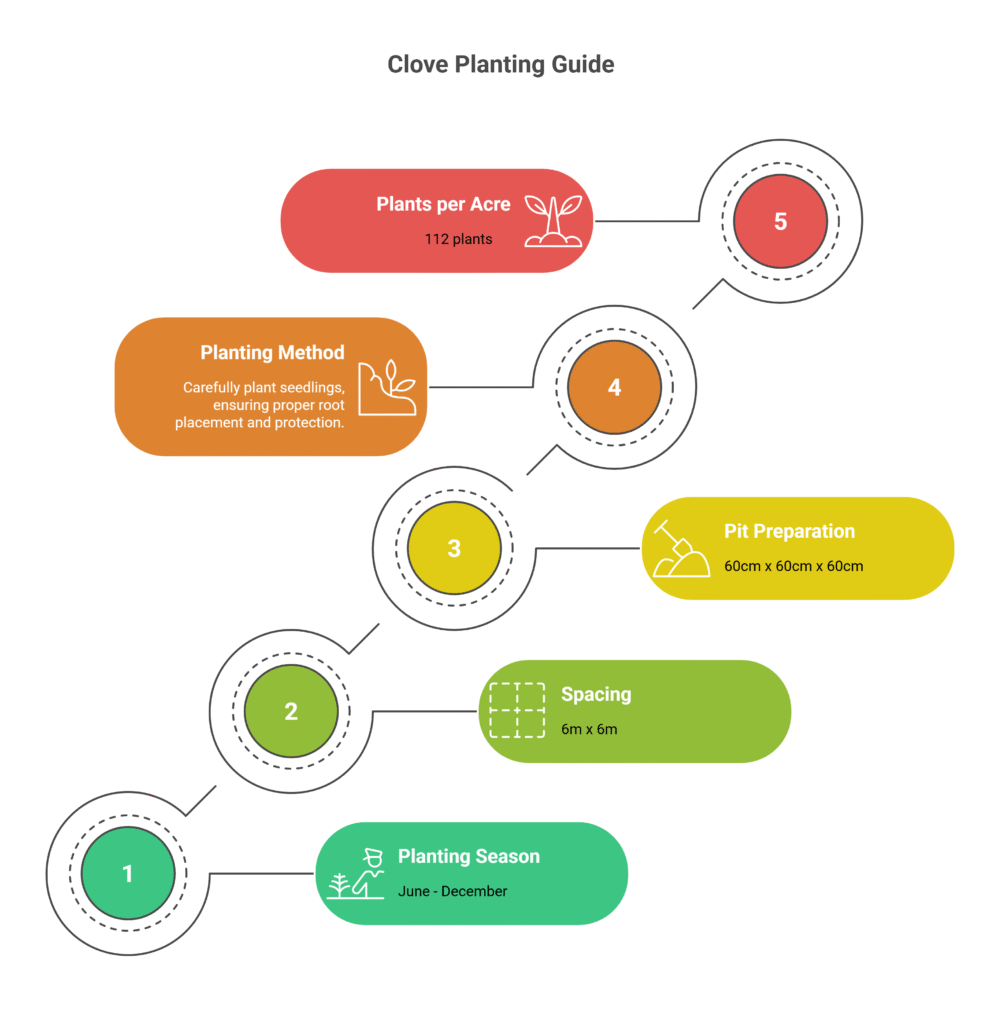
b). Spacing
The standard spacing recommended for clove cultivation is 6 m x 6 m.
c). Pit Preparation
About one to two months prior to planting, dig holes of 60 cm by 60 cm by 60 cm at the designated locations, making sure the topsoil and subsoil are kept apart. Add 150 g of rock phosphate or superphosphate, 50 g of neem cake, 50 g of Trichoderma viride, 10–15 kg of well-rotted farmyard manure (FYM) or compost, and topsoil to each pit. To allow for settling over time, fill the pits just above ground level.
d). Planting Method
For clove planting, choose healthy nursery seedlings that are 8–12 months old, about 20–25 cm in height, and have 5–6 leaves. Carefully remove the seedling from its polybag or pot without disturbing the root ball. In the center of the prepared pit, dig a small hole and place the seedling upright, ensuring the root ball sits slightly deeper than it was in the nursery, while keeping any graft union above the soil surface.
Firm the soil gently around the root zone to secure the plant, water it thoroughly right after planting, and provide temporary shade—such as palm leaves or a shade net—to protect the young plant during its early growth stage.
e). Number of Plants per Acre
112 plants per acre.
Intercropping
Intercropping in clove plantations is highly recommended during the first 5–8 years before the clove canopy closes, as it provides additional income and aids in weed control. Suitable intercrops include shade-tolerant or low-growing crops such as banana (which also offers initial shade), pineapple, ginger, turmeric, taro (Colocasia), vegetables like chillies and beans, and leguminous cover crops for green manure.
Tall, competitive, or nutrient-exhaustive crops like maize and sugarcane should be avoided. Proper management is essential to prevent intercrops from competing excessively for water and nutrients, particularly near young clove plants, and adequate distance must be maintained from the clove trunks.
Irrigation
Regular irrigation is critical for clove cultivation, especially during dry periods and for young plants (under 4-5 years old). While mature trees are more resilient, they still require irrigation during prolonged drought to ensure good flowering and yield.
Water young plants every 3-4 days in the absence of rain; mature trees need water every 10-15 days during dry seasons. Efficient methods include basin irrigation, drip irrigation (preferred), or sprinklers, always avoiding waterlogging. Crucially, maintaining adequate soil moisture during the bud development stage (2-3 months before harvest) is essential for achieving optimal bud size and quality.
Fertilizer and Manure
Fertilizer requirements for clove trees must first be determined through soil testing. Apply fertilizer in a ring 30 to 45 cm wide around each tree, starting approximately 30 cm away from the trunk. After spreading the fertilizer, gently mix it into the soil and follow with thorough watering. Young trees (typically 1-5 years old) should receive only ⅓ to ½ of the full dosage recommended for mature trees, with the amount gradually increased annually as the tree develops. The recommended fertilizer should be applied in two equal split doses—first in May or June and the second in September or October—to ensure optimal nutrient availability throughout the growing season.
| Application Type | Material & Rate (Per Tree/Year) | Method & Notes |
| Annual Application | ||
| – Organic | 20-25 kg well-rotted FYM (Farmyard Manure) or compost | Apply around the tree basin. |
| – Biofertilizer | • Azospirillum: 50g • PSB (Phosphorus Solubilizing Bacteria): 50g • Potash Mobilizing Bacteria: 50g • Mycorrhiza: 100g | Apply to soil. |
| – Inorganic (NPK) | • Nitrogen (N): 60g (e.g., Urea: 130g) • Phosphorus (P₂O₅): 60g (e.g., Superphosphate: 130g) • Potassium (K₂O): 150g (e.g., Muriate of Potash: 250g) | Apply in 30-45 cm wide ring, 30 cm from trunk. Mix gently into soil and water thoroughly after each application. |
| Micronutrients | • Zinc: 0.5% Zinc Sulphate foliar spray • Boron: 0.2% Boron foliar spray | Foliar application only. Apply based on leaf/tissue analysis or visible deficiency signs. Optional. |
Weed Control
Weed control in clove cultivation is crucial, especially during the early years. Manual weeding is essential around young plants, with weed-free circles of about 1 meter in diameter maintained around each tree; this should be done 4–6 times annually in the initial stages, with frequency decreasing as the canopy develops.
Mulching is highly recommended, using a 10–15 cm layer of organic materials like dried leaves, grass clippings, or coir pith within the weeded circle—keeping it away from the trunk—to suppress weeds, retain soil moisture, regulate temperature, and enrich organic matter. Intercropping with suitable crops also helps suppress weed growth in the inter-row areas.
Chemical weed control, such as the use of glyphosate, should be done cautiously and only as a directed spray on weeds in inter-row spaces, ensuring no contact with clove plants, especially green stems. Herbicides are not recommended near young trees, and pre-emergent herbicides are rarely used.
Flowering and Fruit Management
Clove seedlings typically begin flowering at 4 to 5 years old (with budded/grafted trees potentially flowering earlier), reaching peak production between 15 to 20 years of age. Flowering occurs once or twice annually, varying by region and climate, often triggered by a distinct dry period; primary seasons are September–October (harvested December–January) and March–April (harvested June–July).
Buds develop at branch tips, progressing from green to pinkish-yellow (“pink bud” stage), and finally maturing into harvest-ready reddish-brown unopened buds. Key management practices include ensuring adequate moisture and nutrients during bud development, preventing water stress, and pruning dead/diseased branches to improve light penetration and air circulation within the canopy for optimal flowering and yield.
Pest and Disease Management
Common Pests
a). Stem Borer
Stem Borer is a common pest in clove cultivation, with larvae that bore into stems and branches, leading to wilting and dieback of affected parts. Effective control involves removing and destroying infested branches and injecting kerosene or carbaryl into boreholes.
Additionally, applying carbaryl paste or smearing the stem and branches with Carbaryl 50 WP at 2 g per liter of water helps protect the plant. Pouring Quinalphos 25 EC at 1 ml per liter into the borehole and plugging it is also recommended. Soil application of Phorate at 60 g per tree further aids in controlling the pest. Encouraging the presence of predatory ants can provide natural biological control.
b). Scale Insects
Scale insects, sap-sucking pests, weaken clove plants and encourage sooty mold growth on leaves and stems. Effective control involves foliar spraying with options like dimethoate (1 ml/L), malathion (0.1%), or neem oil. Additionally, promoting natural enemies such as parasitoids and predatory insects helps maintain population balance.
c). Mealybugs
Mealybugs cause damage similar to scale insects by sucking plant sap, leading to weakened growth and potential sooty mold development. Control measures include spraying Dichlorvos at 0.05%, Malathion at 0.1%, or neem oil to manage infestations effectively.
d). Thrips
Thrips damage clove plants primarily by feeding on buds and flowers, causing deformation and scarring; to control these pests, apply a foliar spray of Dimethoate at a concentration of 1 milliliter per liter of water.
e). Leaf eating Caterpillar
Leaf-eating caterpillars feed on clove leaves, reducing photosynthetic activity and overall plant vigor. They can be effectively controlled by spraying Quinalphos 25 EC at a concentration of 2 ml per liter of water.
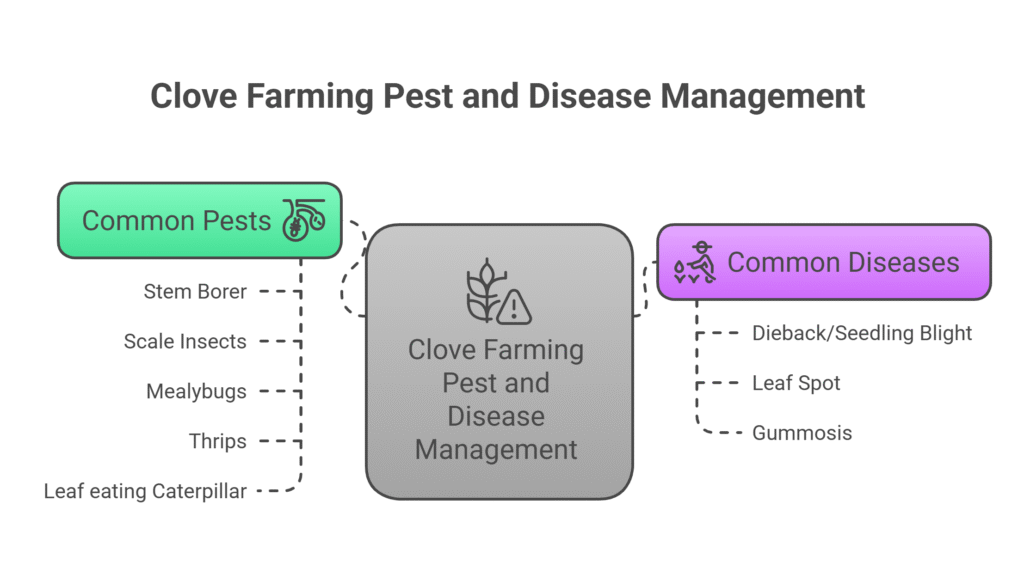
Common Diseases
a). Dieback/Seedling Blight
Dieback or Seedling Blight affects clove seedlings and young trees, causing wilting and dieback of shoots. Effective control involves improving soil drainage and avoiding waterlogging. Drenching the soil with Copper Oxychloride at 0.3% or Carbendazim at 0.1% helps manage the disease and protect young plants from further infection.
b). Leaf Spot
Leaf Spot in clove is characterized by the appearance of spots on leaves, often leading to defoliation. Effective control includes spraying Mancozeb at 0.25% or Copper Oxychloride at 0.3%. Additionally, spraying the foliage with Carbendazim at 0.1% or applying a prophylactic Bordeaux mixture at 1% can help prevent the disease and protect the plant from further spread.
c). Gummosis
Gummosis in clove is identified by gum oozing from the trunk, bark splitting, and rapid wilting of the plant. Control is challenging, but effective measures include improving drainage and overall soil health, removing severely affected trees, and drenching the soil with a combination of Trichoderma and copper-based fungicide. To manage the infection more effectively, the infected portion of the trunk should be carefully scratched and treated with Bordeaux paste. Preventing root injuries is also crucial to reduce the plant’s susceptibility to the disease.
Harvesting
Clove harvesting begins in years 4-5, though initial yields are very low (a few kg per tree); harvesting at the precise time is critical for quality, requiring buds to be picked when they are fully grown (1.5–2.0 cm long), plump, pinkish-red, and still unopened—harvesting too early (green) or too late (opened flowers) drastically reduces quality and essential oil content.
The standard method is careful hand-picking: workers climb ladders or trees to snap off cluster stalks bearing mature buds, avoiding damage to adjacent buds or branches. Due to sequential bud maturation, harvesting occurs over 2–3 months, with pickings repeated every 7–10 days during the peak season.
Processing follows immediately: harvested buds are dried (preferably sun-dried for 4–7 days) until they lose about two-thirds of their weight and turn dark brown and hard, forming marketable “cloves”—proper drying is essential for storage and oil retention—followed by winnowing to remove stalks and stems.
Yield
A well-managed mature clove tree can produce an average yield of 2.5 to 3.5 kg of dried cloves per year.
Cost of Investment per Acre for Clove Farming
| S.N. | Category | Cost (NRs) |
| 1 | Land Preparation (Plowing) | 15,000 |
| 2 | Pit Digging | 15,000 |
| 3 | Plant Saplings (112 saplings) | 33,600 |
| 4 | Fertilizers and Manure | 25,000 |
| 5 | Irrigation | 25,000 |
| 6 | Weed Control (Pre & Post-emergence) | 10,000 |
| 7 | Pest & Disease Control | 6,000 |
| 8 | Harvesting | 10,000 |
| 9 | Drying & Cleaning | 15,000 |
| 10 | Miscellaneous Costs | 10,000 |
| Total Initial Investment | 164,600 |
Annual Maintenance Cost Per Acre for Clove Farming
Starting from the second year of clove cultivation, annual maintenance costs typically range from NRs. 50,000 to NRs. 75,000 per acre, depending on the level of management, labor availability, and input prices. These costs include expenses for activities such as weeding, mulching, irrigation, fertilization, pest and disease control, pruning, shade management, and general upkeep of the plantation. For financial planning and profitability assessments, an average maintenance cost of NRs. 62,500 per acre is generally used as a representative figure, reflecting moderate input use and standard management practices under typical field conditions.
Income per acre from Clove Farming
| Year(s) | Yield/Tree (kg) | Yield/Acre (kg) | Price (NRs/kg) | Annual Income (NRs) |
| 4th Year | 0.05 | 5.6 | 600 | 3,360 |
| 5th Year | 0.10 | 11.2 | 600 | 6,720 |
| 6th Year | 0.25 | 28.0 | 650 | 18,200 |
| 7th Year | 0.50 | 56.0 | 650 | 36,400 |
| 8th Year | 0.75 | 84.0 | 650 | 54,600 |
| 9th Year | 1.00 | 112.0 | 650 | 72,800 |
| 10th Year | 1.50 | 168.0 | 700 | 117,600 |
| 11th–15th Year | 2.00 | 224.0 | 750 | 168,000 |
| 16th–30th Year | 3.00 | 336.0 | 750 | 252,000 |
| 31st–50th Year | 2.00 | 224.0 | 800 | 179,200 |
Analysis of Clove Farming Profit Per Acre
The break-even point in clove cultivation is achieved in Year 15, when cumulative profit shifts from a loss of NRs. 99,920 in Year 14 to a positive return of NRs. 68,080. The peak profit phase spans from Year 16 to Year 30, during which the plantation generates approximately 71.5% of the total profit, amounting to NRs. 2,842,500. During these peak years, the annual net profit is estimated at NRs. 189,500, calculated as the difference between the gross income of NRs. 252,000 and the average annual maintenance cost of NRs. 62,500.
Cumulative Profit Timeline
| Year | Annual Profit (NRs) | Cumulative Profit (NRs) |
| 1 | -164,600 | -164,600 |
| 3 | -62,500 | -289,600 |
| 5 | -55,780 | -404,520 |
| 8 | -7,900 | -482,820 |
| 9 | +10,300 | -472,520 |
| 10 | +55,100 | -417,420 |
| 15 | +105,500 | +68,080 |
| 20 | +189,500 | +1,000,580 |
| 30 | +189,500 | +2,952,580 |
| 50 | +116,700 | +5,286,580 |
Sources
Food and Agriculture Organization (FAO)
ICAR-Indian Institute of Spices Research (IISR)
Spices Board India
Nepal Agricultural Research Council (NARC)
Tropical Agricultural Research (Sri Lanka)

